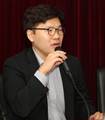
报告人:Prof.Yong Mook Kang,Korea University
报告时间2020/11/8 09:00-12:30
报告地点:腾讯会议:https://meeting.tencent.com/s/BlLpmumlPEH8,
会议ID:795 509 380,直播地址:https://meeting.tencent.com/l/KkPF7vlHEEaJ
Abstract:Phase transformation of layered structure into spinel structure has been detrimental for most of layered oxide cathodes. Even if a lot of efforts have been made to relieve this highly irreversible phase transformation, there have been few successful results. However, we firstly observed the possibility to make this irreversible phase transformation extremely reversible by utilizing Na-birnessite (NaxMnO2•yH2O; Na-bir) or Li-birnessite (Li-bir) as basic structural units, which have distinctive layered structure containing crystal water. Herein, the crystal water in the structure contributes to generating metastable spinel-like phase, which is the key factor for making this unusual reversibility happen. The reversible structural rearrangement between layered and spinel-like phases during electrochemical reaction could activate new cation sites and enhance ion diffusion with higher structural stability. This unprecedented reversible phase transformation between spinel and layered structure was also observed for the Na-bir or Li-bir with some organic moelcules in place of crystal water finally setting a significant precedent for organic-inorganic hybrid electrodes for alkali ion batteries. All of materials were carefully analyzed via combined ex situ soft and hard X-ray absorption spectroscopy (XAS) analysis with in situ X-ray diffraction (XRD). Fundamental mechanism on this reversible phase transformation was theoretically elucidated and confirmed by kinetic investigation using first-principle calculation. These results provide deep insight into novel class of intercalating materials which can deal with highly reversible framework changes, and thus it can break up some typical prejudices which we have about the layered cathodes for Li or Na secondary batteries.
Biography:
Prof. Yong-Mook Kang completed his B.S. (1999), M.S. (2001), and Ph.D. (2004) in Korea Advanced Institute of Science and Technology. He has been a senior researcher in Samsung SDI Co., LTD. He is currently a full professor inKorea University. His research area covers electrode or catalyst materials for Li rechargeable batteries and various post Li batteries, such as Li-air battery, Na rechargeable battery and so on. To date, he has co-authored more than 100 refereed journal articles, more than 50 domestic or international patents, several articles in books or proceedings, and a textbook of nano-science and electrochemical devices. For his research achievements in energy conversion & storage materials, he was elected as a TWAS(Academy of Science for Developing Worlds) Young Affiliate for the first time in South Korea, and awarded the International Collaboration Award of Australian Research Council-2010. From 2015, he has been elected as a RSC (Royal Society of Chemistry) fellow & representative in Korea.
